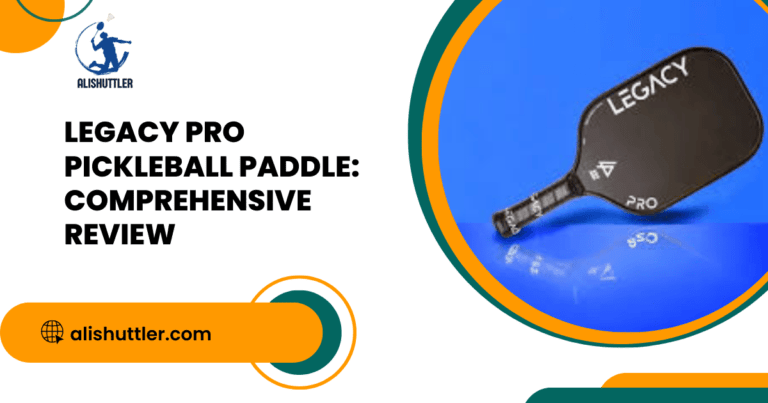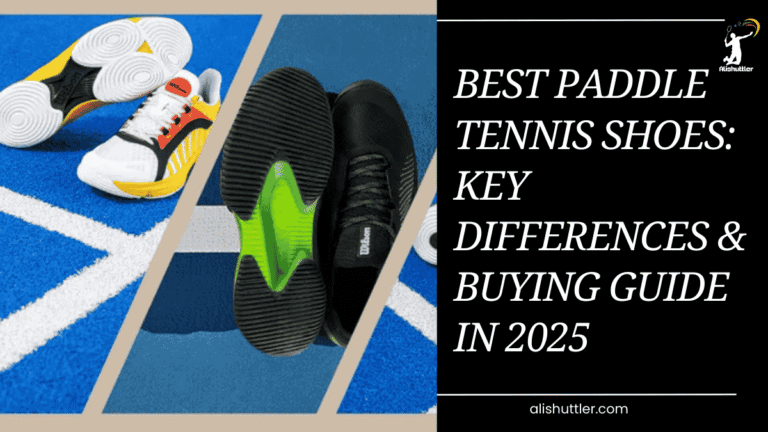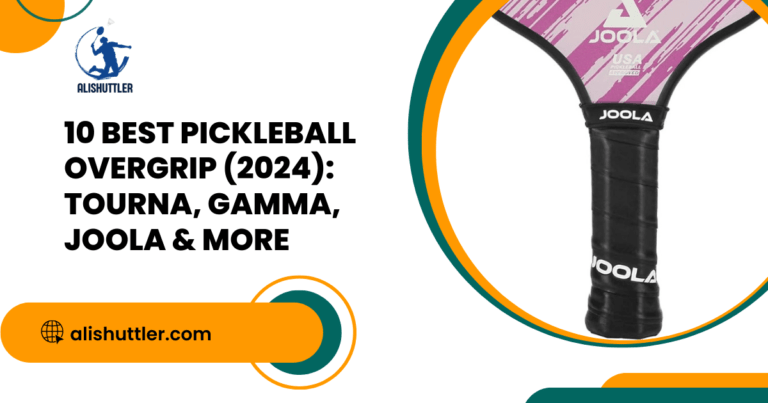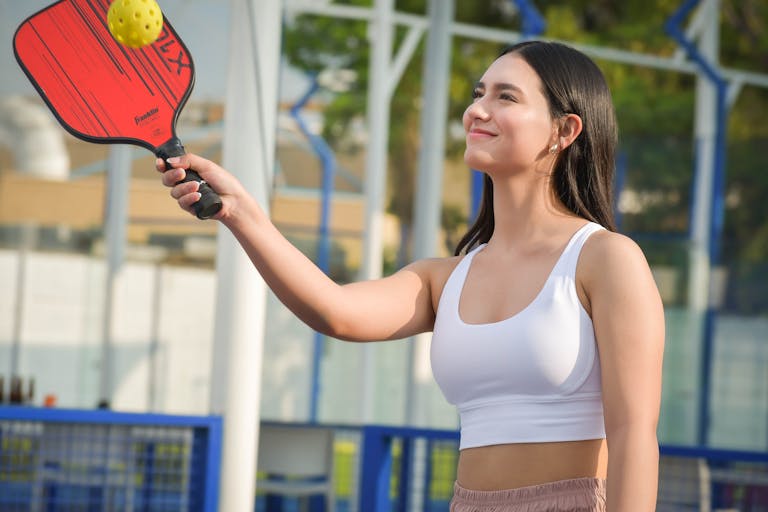Pickleball vs tennis refers to two most loved racquet sports with obvious variations in play, equipment, and court dimensions.
Pickleball employs a smaller paddle, plastic ball and a court roughly one quarter the size of a tennis court. Tennis utilizes a stringed racquet, a felt ball and a larger court.
Both games require skill and quickness but each has a unique flow. Next up, a closer comparison of what differentiates them.
Core Distinctions

Pickleball and tennis share some similarities, yet their core differences, particularly in terms of court dimensions and equipment like the pickleball paddle versus the tennis racquet, distinguish them quite drastically. Below, there’s a side-by-side table for quick comparison, followed by deeper dives into the distinctions for each area.
| Feature | Pickleball | Tennis |
|---|---|---|
| Court Size | 13.4m x 6.1m (smaller, non-volley zone) | 23.8m x 10.97m (doubles) |
| Surface | Concrete, asphalt, or gym flooring | Asphalt, concrete, clay, grass |
| Net Height | 0.86m in center | 0.91m in center |
| Paddle/Racquet | Solid paddle (no strings), 15–20cm wide | Strung racquet, 27cm+ wide |
| Ball | Plastic ball with holes (26/40) | Pressurized, fuzzy tennis ball |
| Serving | Underhand, two serves allowed | Overhand/underhand, one serve |
| Scoring | First to 11/15 pts, win by 2 | Games, sets, matches (15/30/40/adv) |
| Rally Length | Shorter, faster exchanges | Longer, slower rallies |
1. The Court
Pickleball courts are a fraction of the size of tennis courts, at 13.4 meters by 6.1 meters. Tennis courts span a much greater area, extending to 23.8 meters by 10.97 meters for doubles. This size distinction translates to less ground to cover in pickleball, which is less straining on the legs and joints.
While both sports operate on unforgiving concrete or asphalt surfaces, pickleball, in particular, has found a home on gleaming gym floors of numerous community centers. Tennis courts in clay and grass varieties alter the game’s pace and technique.
Pickleball courts have a “non-volley zone” or “kitchen” running 2.13 meters from the net on each side, where volleys are prohibited. Tennis court lines and nets are engineered for those extended rallies and wider strokes.
Pickleball’s smaller court employs a lower net and tighter line configuration. Lots of tennis courts are now getting painted with pickleball lines, enabling multi-use play at parks and clubs.
2. The Gear
The core equipment for pickleball consists of a solid paddle often constructed from composite, wood or graphite and a plastic ball with 26 or 40 holes. These paddles weigh significantly less than tennis racquets, typically between 200 and 250 grams.
By comparison, tennis racquets have strings and weigh 285 to 340 grams, which influences the way you strike and spin the ball. Pickleball paddles feature a shorter, broader grip, whereas tennis racquets have longer handles to accommodate two-handed strokes and provide extra reach.
Grip styles vary—pickleball grips are more akin to ping-pong paddles, while tennis promotes different grips on the forehand and backhand. The lighter pickleball gear accommodates rapid wrist flicks, while tennis requires more arm and shoulder strength.
3. The Rules
Pickleball’s rules emphasize inclusivity and rapid play. The double bounce rule says that the ball needs to bounce one time on each side prior to the serve, volleying can begin, which decelerates the game and presents both sides an equal opportunity.
Serving is underhand, and you get two shots to get the ball in. The non-volley zone, or kitchen, prevents players from smacking volleys too near the net, which contributes a safety component and alters the style of play.
Tennis rules are harder, with overhand serves, one serve only and games scored 15, 30, 40, game. There is no non-volley zone, meaning net play is more aggressive.
While both sports have singles and doubles, pickleball frequently takes place in a more social, open-play environment where partners rotate frequently.
4. The Pace
Pickleball games move quickly. Shorter rallies and faster exchanges imply that quick reflexes are essential. The shorter court results in more net play so players depend on quick reflexes instead of long sprints.
Tennis features longer rallies and more distance to cover, thus endurance and footwork play a more significant role. Pace alters shot selection—pickleball is a game of touch and quick hands, while tennis favors forceful groundstrokes and thick topspin.
Pickleball’s smaller court size means less running and more dinking at the net. Tennis requires more ground to be covered, so endurance frequently determines matches.
5. The Score
Pickleball uses a simple system: games to 11 or 15 points, win by two. Only the serving side can score points, so the pace of scoring can change frequently.
Tennis employs games, sets and matches with points counted as 15, 30, 40 and game. Serve is a huge component in winning points but either player can score on any rally.
Pickleball scoring maintains attention on quick sprints, while tennis rewards endurance over a prolonged contest.
Physical Impact
Pickleball and tennis both push the body in different ways, with distinct differences in their physical demands. While many tennis players enjoy the intensity of playing tennis, the nature of the pickleball serve and the compact swing required can also provide significant physical benefits, coloring a player’s experience in the long run.
Injury Profile
Pickleball has its own injury signature. While many players suffer from wrist strains and ankle sprains, there is a significant risk of lower body injuries as well. Achilles tendon issues, ACL tears, knee soreness, and hip arthritis are all pretty common, particularly in older adults. Muscle tears in the legs can occur, typically due to rapid, unexpected movements on the pickleball court.
A 2021 study revealed that 86% of pickleball injuries seen in emergency rooms were among those over 60. Bad shoes tend to compound the problem, and an added hiccup with beginning pickleball later in life is that players may already have joint wear, such as knee arthritis or meniscus tears, which can affect their pickleball participation.
Tennis presents its own hazards. Tennis elbow, shoulder pain, and rotator cuff injuries are standard, as is strain to knees and ankles from rapid accelerations and decelerations. Both sports produce lower extremity injuries; however, many tennis players tend to have more upper body strain due to the larger, heavier racquet and longer swings compared to a pickleball paddle.
To reduce the risk of injury, athletes in both sports need to prioritize proper mechanics, wear appropriate footwear and prevent overuse. Mastering form and grip can translate to less strains and sprains. Breaks and listening to your body and not pushing through pain are all key.
Warm-up’s count. Easy stretches, light jogging, and mobility work prior to play assist your muscles in preparation. Cooling down after play is equally as important for injury prevention.
Fitness Benefits
- Boosts balance and agility
- Supports heart health through aerobic activity
- Builds core and leg strength
- Increases flexibility and joint range of motion
- Sharpens hand-eye coordination
Tennis and pickleball both assist with muscle strength and flexibility. Tennis tends to exercise the upper body more, whereas pickleball demands quick, low movements and acute footwork. Both sports can keep you in shape if you play them frequently.
Social play is a powerful incentive. Both are very easy to initiate as a social activity, which helps people maintain consistent exercise.
Playing Surfaces and Impact
Pickleball is typically played on hard surfaces such as concrete or asphalt. Tennis comes in grass, clay or hard courts, all of which impact the body differently. Hard courts, typical to both sports, can be rough on joints and cause injuries, particularly with extended or higher intensity sessions.
Soft surfaces reduce knee and hip shock, but not every player has them available.
Long-Term Physical Effects
Either sport, played long-term, builds endurance and can sustain healthy aging. Both provide a total body exercise that assists in weight management and bone density.
For others, joint wear, particularly in the knees and hips, can accumulate over time, largely as a result of pounding on firm surfaces and high-impact maneuvers.
Learning Curve
The learning curve determines how quickly new players can get going, have fun, and excel at a sport. Pickleball’s easy to learn, especially compared to playing tennis, which requires mastering more complex tennis skills on a larger court. While both sports reward consistent practice, the path to becoming a great pickleball player or seasoned tennis player can appear very different.
For Beginners
Pickleball’s small court and slower ball speed, in particular, make it easy for newbies to jump in. Start with the fundamentals, such as serving underhand, keeping the ball in play and the double bounce rule. Practice your fore- and backhand small, controlled swings.
Signing up for beginner leagues or classes can accelerate your learning. These environments provide the discipline and response necessary for acquiring skills correctly. Most pickleball clubs are incredibly supportive, embracing new players with open arms and welcoming them in.

Practicing frequently, even only a few times a week, develops muscle memory and confidence.
For Crossovers
- Concentrate on shorter swings. Pickleball paddles react optimally to small strokes.
- Adjust footwork for smaller courts and less running.
- Master the double bounce rule and non-volley zone (“kitchen”).
- Work on dinking (soft shots) at the net, a crucial pickleball skill.
Tennis comes to the rescue in pickleball, particularly in shot placement and reading the ball. Tennis players might adjust more quickly to serving and volleying, but must switch strategy for the slower, softer game.
The variation in paddle size, short court length and quirky rules such as the kitchen line may take a while to get used to. The cross-training between these two sports develops overall coordination and agility.
Steepness of Learning
Tennis is a more difficult learning curve. The rules are trickier, and the court (roughly 23.8 by 10.9 meters for doubles) involves more running. To hit powerhouse shots, to master serves and be returning fast balls requires hours of drills and lessons.
Newcomers can be crushed by the pace and scale of the game. Pickleball courts, measuring only 13.4 by 6.1 meters, require much less running and a longer rally duration, which makes the sport more forgiving for novices.
The ball moves slower, allowing new players more time to strategize shots. Learning the double bounce rule is a peculiar hurdle but injects a tactical edge once grasped.
Progression and Mastery
Both sports require consistent practice to get better. Racquet players, such as those with experience playing badminton or squash, should have a quicker time mastering pickleball.
As you become more skilled, the learning curve flattens, with higher-level strategies and nuanced techniques to fine tune.
Strategic Mindset
A strategic mindset in pickleball and tennis is all about thinking in advance, planning out moves, and making decisions that drive point scoring over the long term. Both games encourage players to identify patterns, anticipate the other side, and make clever moves. Knowing each sport’s rules and court dimensions allows players to select the optimal means of scoring, conserving energy, or defending.
Offensive Plays
In pickleball, dinks are those soft shots you hit to get the play up to the kitchen so you can make them miss. The drop serve is critical, allowing the ball to fall short over the net, making it difficult for the opponent to strike. Volleying at the kitchen line is frequent, and these important shots help dictate the rhythm and generate opportunities to end points. The standard pickleball court enhances the dynamics of these exchanges.
Tennis employs powerful serves, penetrating groundstrokes, and quick net attacks. Players can rally from the baseline and then come in for a volley or a smash. Power and placement both count, but so does varying the pace to keep your opponent off balance. Unlike the compact swing often seen in pickleball, tennis rewards wide angles and deep shots, particularly when the opposite side is out of position.
Identifying and exploiting weak spots is essential in both games. On pickleball, you can go after the backhand or draw a dink return by alternating easy and hard shots. In tennis, they were attacking a weaker side or pulling opponents off the court with angled shots. This sort of shot selection, guided by your opponent’s weaknesses, is a dead giveaway of a strategic mindset.
Doubles play in both sports introduces another dimension. Teamwork gets you offensive plays, such as poaching at the net in tennis or fast switches at the kitchen in pickleball. Good teams communicate frequently and strategize, rendering them more difficult to conquer.
Defensive Plays
Pickleball defense is all about intelligent footwork and being vigilant. Players have to span the court, prepare for lightning volleys and anticipate shots. Remaining behind the kitchen line allows you to respond to dinks and power shots alike.
Defense in tennis frequently refers to returning powerful serves and transforming defense into offense with passing shots or lobs. They rely on speed to track down deep balls and attempt to reset the point with a safe stroke. Good defense can exasperate an enemy and induce mistakes.
Court awareness is understanding where you are, where your partner is, and where the threat is originating. Both sports reward players who keep their eyes open and adjust quick.
Defensive skills can make a difference in a match. A perfectly-timed lob or block can stem a powerful attack and open fresh opportunities to score.
Social Scene
Pickleball and tennis unite people, but they foster different social universes. To most, the camaraderie and togetherness on the pickleball court is just as much a draw as the game. They all deepen player connection and retention through social bonds, club culture, and events.
Community Vibe
Pickleball has earned a name for being accessible to everyone, regardless of their age or ability. The sport’s low barrier to entry means you’ll frequently witness kids, adults, and seniors occupying the same court. This blend goes a long way in making newcomers feel at home.
While it gets a lot of attention from younger players, you’ll frequently see folks who aren’t as fit as they used to be trying pickleball, as its slower pace and smaller court make it less hard on the body.
Tennis can be social as well, but depends on the vibe of where you play. A few clubs have open sessions and beginner nights to get new members talk to people. Still, most tennis clubs carry a mood that is a bit more competitive.
There are usually ranking ladders, team tryouts and a focus on skill level that can make it difficult to find your place initially. Social media is accelerating pickleball’s growth even further. Online groups and forums allow players to exchange tips, arrange games, and discuss equipment.
A lot of local clubs have chat apps that keep members in the loop about events. This digital side serves to connect players who may not have met in the flesh and creates a broader community feeling. Signing up for local leagues or tournaments is a great way to connect with others in either sport.
A lot of cities operate open days for new players or social play, and both sports frequently host charity games or theme nights. These environments assist in establishing initial connections and facilitate the development of genuine friendships.
Club Culture
Pickleball clubs offer a more fun and social play environment. Most clubs accept walk-ins, allowing you to come as a guest or register for a day, making it easier for new pickleball players to join in. With fewer expectations to perform at a high level, the vibe is chill, attracting those who play for exercise or just to hang out with friends. In contrast, tennis clubs typically follow a membership model, which includes mandatory fees and court bookings that can be less inviting for casual players.
The configuration of pickleball courts is ideal for individuals looking to join squads, attend classes, or engage in ranked games. However, some tennis clubs have experienced declines as players switch to pickleball for a more relaxed atmosphere. Games are crucial in both sports, and club mixers, social doubles, and holiday match-ups foster connections off the court.
The configuration is good for those looking to join squads, attend classes or play ranked games. Yet, a few clubs have experienced declines as folks switch to pickleball for a mellower vibe. Games are crucial in both sports.
As parks convert tennis courts to dedicated pickleball courts and new clubs emerge, the nature of social connection within these racquet sports is evolving. This shift reflects the growing popularity of pickleball, making it an attractive option for those seeking a community-oriented athletic experience.
Ultimately, the differences between the two sports shape player experiences and preferences. While tennis players may enjoy the competitive structure of tennis matches, many are also discovering the benefits of engaging in pickleball, further blurring the lines between these two beloved racquet sports.
Future Trajectory
Pickleball & tennis are both evolving rapidly. Who plays, where we play, how we play it’s all changing. Their trajectories are a matter of participation trends and shifting demographics and new growth elsewhere in the world.
Here is a table comparing recent growth and changes for both sports.
| Trend | Pickleball | Tennis |
|---|---|---|
| 3-Year Growth Rate | 223% | 10% |
| Monthly Players | Surpassed tennis | Slight increase |
| Demographic Trends | Seniors, all ages | Strong youth base, all ages |
| Facility Expansion | Courts outnumber tennis in some areas | Stable, but slower expansion |
| Global Reach | Emerging worldwide | Long-standing, global presence |
| Professional Leagues | Rapid growth, big investments | Established, major tournaments |
Global Growth
Pickleball vs tennis. Pickleball is rapidly catching on beyond its home shores, with many tennis players now exploring the sport. It’s played in Canada, Australia, India, and parts of Europe. Tournaments and social groups have sprung up in cities that had never even heard of the game a few years back, showcasing the growing popularity of pickleball courts.

Tennis still has a foothold in many areas, thanks to global events like the Grand Slams and its long history. This racquet sport has an avid worldwide following, being taught in schools and played in clubs, while millions view tennis matches.
Pickleball is meanwhile beginning to create its own mega-events, but a few emerging pro tours are attracting audiences and press. The opportunity for pickleball to continue its growth is significant. Its tiny learning curve and emphasis on fun have everyone giving it a whirl, even people who never played racket sports.
Televised matches and sponsorships will certainly bring even more players around the world, enhancing the overall pickleball participation and excitement for the sport.
Demographic Shifts
Pickleball has become a seniors’ hit with its simple rules and compact courts. This arrangement reduces the potential for injuries and enables seniors to maintain an active, social lifestyle. It’s not only for seniors. Kids, teens and adults all play, demonstrating the sport’s broad appeal.
Tennis, meanwhile, maintains its bite with juniors and high school squads. It’s still a premier option for players seeking highly competitive action and a route into the world stage pro scene. Yet, more kids and families are taking up pickleball, attracted to its amicable competition and quick rounds.
Both sports are more accessible today, with public parks and clubs readily available for anyone to participate. This drive for open play, inexpensive gear, and less demand for peak fitness has helped Pickleball vs tennis access new audiences.
Shifting attitudes towards health and fitness have led to a search for sports that complement hectic lifestyles. Pickleball’s short games and social vibe hit these needs, while tennis still provides a timeless route for those seeking an uphill battle.
Final Thoughts on Pickleball vs tennis
Pickleball vs tennis both offer competitive play, serious skill development, and space for genuine enjoyment. Small pickleball court, quick rounds, and teamwork! Tennis entices with long rallies, more room to maneuver and deep technical work. Both raise heart rates and unite people, regardless of age or ability.
Some opt for the fast, airy style of pickle, while others crave the tempo and stretch of tennis. Choose whichever suits your mood, body or group. Try them both to see what feels right. Sound off or share your own tales of your default sport. Your opinion assists everyone else choose what fits them.
Frequently Asked Questions
What are the main differences between pickleball and tennis?
Pickleball features a smaller court and uses a plastic ball, while tennis courts are larger, employing heavier rackets and felt-covered tennis balls, highlighting the distinct differences in equipment and gameplay.
Which sport is easier to learn, pickleball or tennis?
People generally consider pickleball simpler to pick up, especially on a standard pickleball court. With its smaller court, slower ball speed, and simple rules, pickleball allows beginners to hit the ground running compared to playing tennis.
Is pickleball less physically demanding than tennis?
Yep, pickleball is less physically demanding due to the smaller pickleball court, shorter rallies, and less strenuous movement, making it accessible to varying ages and fitness levels.
Can pickleball or tennis improve your fitness?
Both sports enhance cardiovascular health, coordination, and agility. While playing tennis is often more demanding in terms of running, frequent pickleball sessions provide a more moderate workout, showcasing their distinct differences in fitness benefits.
Which sport offers a stronger social community?
Both pickleball and tennis got busy social lives, with pickleball courts fostering an inclusive, community-driven spirit that appeals to many tennis players of all walks and ages.
How do strategy and skill development compare between the two sports?
Tennis strategies tend to emphasize power and stamina, while pickleball serve strategies focus on rapid reflexes, positioning, and cooperation, highlighting the distinct differences in gameplay.
What is the future outlook for pickleball and tennis?
Pickleball is exploding, gaining more players every year all over the world, while many tennis players still enjoy their sport. However, pickleball’s appeal is snowballing due to its approachability and inclusivity.






